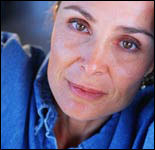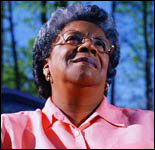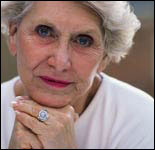CDC Features
Current Features
October is Breast Cancer Awareness Month


Except for skin cancer, breast cancer is the most commonly diagnosed cancer among American women.
Breast cancer is the most common cause of death from cancer among Hispanic women and the second most common cause of death from cancer among white, black, Asian/Pacific Islander, and American Indian/Alaska Native women.
According to the National
Cancer Institute estimates for the United States, in 2007 there will
be:
• 180,510 new breast cancer cases (178,480 female, 2,030 male)
• 40,910 breast cancer deaths (40,460 female, 450 male).
Ways You Can Help Lower Your Risk of Breast Cancer
• Control your weight and exercise. Make healthy choices in the foods you eat and the kinds of drinks you have each day. Stay active. To learn more about keeping a healthy weight and ways to increase your physical activity, visit CDC's Division of Nutrition and Physical Activity and MyPyramid.gov.
• Know your family history of breast cancer. If you have a mother, sister, or daughter with breast cancer, ask your doctor what is your risk of getting breast cancer and how you can lower your risk.
• Find out the risks and benefits of hormone replacement therapy on developing breast cancer. Some women use hormone replacement therapy (HRT) to treat the symptoms of menopause. Ask your doctor about the risks and benefits of HRT and find out if hormone replacement therapy is right for you.
• Limit the amount of alcohol you drink.
Screening and Early Detection
Breast cancer screening means checking a woman’s breast for cancer before there are signs or symptoms of the disease. Three main tests are used to screen the breast for cancer. Talk to your doctor about which tests are right for you, and when you should have them.

• Mammogram. A mammogram is an X-ray of the breast. Mammograms are the best method to detect breast cancer early when it is easier to treat and before it is big enough to feel or cause symptoms. Having regular mammograms can lower the risk of dying from breast cancer. If you are age 40 years or older, be sure to have a screening mammogram every one to two years.
• Clinical breast exam. A clinical breast exam is an examination by a doctor or nurse, who uses his or her hands to feel for lumps or other changes.
• Breast self-exam. A breast self-exam is when you check your own breasts for lumps, changes in size or shape of the breast, or any other changes in the breasts or underarm (armpit).
Which tests to choose: Having a clinical breast exam or a breast self-exam has not been found to decrease risk of dying from breast cancer. Keep in mind that, at this time, the best way to find breast cancer is with a mammogram. If you choose to have clinical breast exams and to perform breast self-exams, be sure you also get regular mammograms.
National Breast and Cervical Cancer Early Detection Program
Through the National Breast and Cervical Cancer Early Detection Program (NBCCEDP), CDC provides low-income, uninsured, and underserved women access to timely, high-quality screening and diagnostic services to detect breast and cervical cancers at the earliest stages.
The NBCCEDP provides screening support in all 50 states, the District of Columbia, 5 U.S. territories, and 12 American Indian/Alaska Native tribes or tribal organizations. An estimated 8–11% of US women of screening age are eligible to receive NBCCEDP services. Find a local program.
October 19, 2007 Is National Mammography Day
As part of National Breast Cancer Awareness Month, the third Friday in October each year is designated as National Mammography Day, to remind women to get a mammogram every one to two years.
On National Mammography Day and throughout National Breast Cancer Awareness Month, women are encouraged to make an appointment to get a mammogram if they have not had one. In honor of National Mammography Day, many accredited mammography facilities will offer free or low -cost mammograms.
Several national organizations have a list of the facilities that participate in National Mammography Day. To find a place near you, call:

• American
Cancer Society
1-800-ACS-2345
• Susan
G. Komen For the Cure
1-800-IM-AWARE
• National
Cancer Institute
1-800-4-CANCER
• Y-ME
National Breast Cancer Organization
1-800-221-2141
For More Information
- Breast Cancer
- Reducing Risk
- Screening
- Understanding Mammograms
- National Breast Cancer Awareness Month*
Page last reviewed: October 8, 2007
Page last updated: October 24, 2007
Content source: Division of Cancer Prevention
and Control
Content owner: National Center for Health Marketing
URL for this page: www.cdc.gov/Features/BreastCancerAwareness
*Links to non-federal organizations are provided solely as a service to our users. These links do not constitute an endorsement of these organizations or their programs by CDC or the federal government, and none should be inferred. CDC is not responsible for the content of the individual organization Web pages found at these links.

